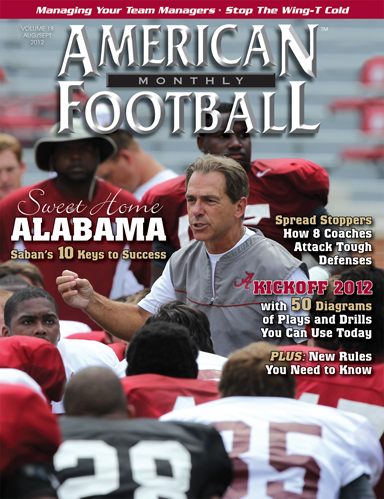Article CategoriesAFM Magazine
|
COMPLEXITY Using Complex Warm-Ups to Jump Start Your Athlete’s Workoutby: Mark HooverStrength and Conditioning Coach • Piedmont High School (NC) © More from this issue All high school strength and conditioning coaches are looking for that “magic bullet” or the one thing that will help their student-athletes make incredible jumps in explosive power. Having your athletes perform “complex” warm-ups will help them achieve that goal. A “complex” warm-up is a series of 6-10 exercises, done for a set number of reps, in consecutive order, without resting or changing weights for the entire set. When we started using complexes, I began to see many benefits. Our form and technique on all Olympic lifts improved and our intensity increased as we no longer needed the “crutch” of the “warm-up” weight which brought down our work production. We saw an increase in the explosiveness of our movements and, as an added benefit, our athletes’ body-fat percentages began to decrease. Simply stated, adding complexes has dramatically increased our overall efficiency. This, in turn, equates to stronger, faster and more explosive players on the field. Strength training is much like any other sport in that most coaches take what they see other people doing and tailor those ideas to fit their needs. While attending the 2009 National Strength and Conditioning Association Clinic at Wake Forest University, I heard Istvan Javorek, former Olympic coach and trainer, speak and demonstrate the use of complexes, which are a major part of his program. Being a “borrower” of great ideas, I decided to incorporate them into our training. The results were outstanding. I started to put together my own version of the complex warm-ups based on what Coach Javorek had outlined. I then looked at what specific exercises and techniques I felt we needed the most work on and decided how best to incorporate them into what we were doing. Since our time was limited, I narrowed our complexes down to a total of five. Three barbell complexes, one dumbbell complex and one focused on squatting movements (See Chart).
The next step was assigning the criteria for what weight to use. If left on their own, players will go in one of two directions - way too light or way too heavy. We decided to use the scientific terminology of “heavy enough to make you sweat, light enough for you to complete without approaching muscle failure”. Unfortunately, that was obviously a terrible coaching point, along the lines of telling an offensive lineman to “just block him” and it confused the athletes. After a little more research on what other coaches were doing, we decided to base the percentage of the exercise within the complex that would be the most difficult weight-wise. In four of the five we had some sort of row built in. Therefore, we decided to set the standard percentage at 40% of their estimated upright row max. Not an exact science, but it ended up being just what we were looking for. For the squat complex, we allowed our athletes to go as high as 135 pounds. The rep range was varied. We stuck within the 3-5 rep range depending on the workout scheduled that day. The exception was the squat complex where we took it up a notch and went 8-10 reps per exercise. We had each athlete go through the set as quickly as possible. One person from each group would be responsible for calling out the order of lifting so the working athlete did not have to stop and look. At first, we spent about ten minutes going through a group of four. Once we got into the routine, we would end up using about six total minutes. My belief and the core philosophy of density training is to condense more production into less time. Be as efficient as possible at all times. This routine was the best use of six minutes a strength coach could ever want. While many coaches use complex routines as a part of the main workout, we decided to stick with them as part of our warm-up. We look at it as taking steps in intensity to build up toward a heavy-duty training session. We use the complexes on a rotating basis on each of the three lifting days per week. I believe it gets the athletes’ motor running a little harder than simply going through a dynamic warm-up routine. If we look at the session as a four course meal, the dynamic work is the first light course, followed by a bit heavier second course of a complex. The main dish is the density training workout. We wrap it up with the dessert of tumbling on the mats to cool down. The use of the complex as part of our routine has, without a doubt, helped to increase our student-athletes productivity on the field and in the weight room. |
|
| HOME |
MAGAZINE |
SUBSCRIBE | ONLINE COLUMNISTS | COACHING VIDEOS |
Copyright 2025, AmericanFootballMonthly.com
All Rights Reserved





